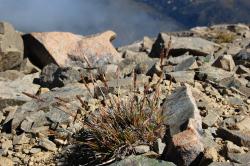- Taxon
- Gallery
Compact tufts 3–20–(55) cm, with stiff leaves, densely pubescent to villous culms usually not much overtopping leaves, and dense ± oblong panicles usually from two to four times as long as wide; branching extravaginal. Leaf-sheath to 3 cm, glabrous to shortly hairy above, to densely pubescent throughout; margins glabrous to ciliate. Ligule 0.5–2–(4) mm, ± erose, truncate to tapered, short-ciliate, abaxially glabrous or with minute hairs. Leaf-blade 1.5–14 cm × 0.5–4.5 mm, rolled or folded, often with inrolled margins, or flat (mainly on Subantarctic Islands), abaxially glabrous except near semipungent minutely prickle-toothed tip, or with sparse prickle-teeth in upper ½, to densely pubescent throughout, adaxially ribbed, sparsely minutely hairy or prickle-toothed, to densely pubescent on ribs; margins with scattered long hairs especially near base, or with short hairs or prickle-teeth. Culm 2–17–(40) cm, internodes either densely villous with soft retrorse hairs, and antrorse hairs just below panicle, or with all hairs antrorse to spreading, or with very short, sparse hairs, exceptionally glabrous on Chatham Is. Panicle 1–6.5–(15) × 0.3–2–(2.5) cm, dense, spike-like, sometimes interrupted near base, oblong, to lanceolate- or ovate-oblong; rachis and branches pubescent. Spikelets 4.3–6.5–(7.4) mm, brownish to greenish, often with purplish bands on glumes and lemmas, later stramineous. Glumes subequal or sometimes unequal, with minute to hair-like prickle-teeth on keel and margins in upper ½, and in Chatham Is, Auckland Is and Campbell Id with minute hairs or prickle-teeth scattered on surface; lower ≤ upper, narrowly elliptic, upper ≤ spikelet, more broadly elliptic; apex subacute to acuminate, sometimes shortly mucronate. Lemma 3.5–6.2 mm, bidentate to conspicuously bicuspid, papillose, minutely prickle-toothed only near base of awn to throughout lemma; awn 2–6.5 mm, straight to recurved, insertion in upper ¼ of lemma. Palea minutely prickle-toothed on upper ¾ of keel or almost throughout, in Subantarctic Is with prickle-teeth also on flanks. Callus hairs 0.2–0.6 mm. Rachilla hairs 0.4–0.8 mm, very sparse to moderately dense. Lodicules c. 1 mm, glabrous or ciliate, dentate or bilobed. Anthers 0.6–1–(1.5) mm. Gynoecium: ovary c. 0.8 mm; stigma-styles c. 1.2 mm. Caryopsis 1.5–1.8 × 0.5–0.7 mm.
[From: Edgar and Connor (2000) Flora of New Zealand. Volume 5 (second printing).]




